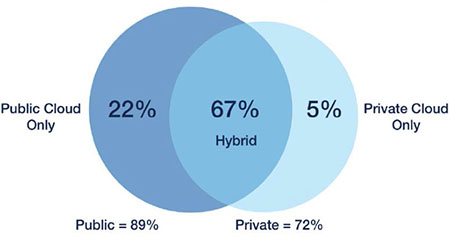The State of the Cloud in 2017
Not too long ago, the words “public cloud” and “media enterprise” had almost nothing in common. Well, at the 2017 NAB Show the public cloud was being praised at nearly every turn by big and small equipment, services and software vendors. The public cloud is only about 11 years old, starting when Amazon first offered IT infrastructure services in 2006. It’s amazing to see the progress this once controversial service has made.
According to International Data Corp., worldwide spending on public cloud resources is expected to increase from $67 billion in 2015 to $162 billion in 2020, attaining a 19-percent CAGR. This is amazing growth and the media enterprise is not immune to this trend.
PUBLIC IS HOT, PRIVATE IS COOLING
Where do we stand today in terms of IT adoption? Let’s turn to a recent survey report from cloud management vendor RightScale, the “2017 State of the Cloud Report.” The report summarizes the results from a survey of 1,002 IT technical professionals across a broad cross-section of organizations about their adoption of the cloud. The report has been compiled annually since 2012, so RightScale has a good memory for how trends have changed since their first report. Here are some of the salient points that are relevant to building media infrastructure and related applications.

Fig. 1: Ninety-five percent of respondents are using the cloud in one form or another.
The survey shows (Fig. 1) that the hybrid cloud is the preferred enterprise strategy with 67-percent adoption while private-only is at 5 percent. Importantly, 95 percent of respondents are using the cloud in one form or another. The percentage of respondents adopting private cloud is 72 percent, down from 77 percent in 2016. This is an important trend and means more companies are trusting the public cloud.
Hybrid cloud is perfect for the media facility. Not all workflows are ready for public-only, whereas some intelligent sharing of local/private and public is practical and leads to more confidence in public-only. All media services organizations (production, post, broadcast, corporate, theatrical, etc.) use apps spanning from editing to media asset management to scheduling to project management and beyond. There are major benefits to the public cloud-based apps model and according to Gartner this segment had a growth rate of 20 percent in 2016 and a value of $38 billion (http://tinyurl.com/Gartner-saas-2015). Many vendors at the NAB Show offered either subscription apps or apps that you can own and run in a cloud of your choice.
One reason for the cooling of the private cloud is the trust in public has surged over recent years. Early on, private was the go-to choice because the public providers lacked trust and overall security was suspect. Well, the pendulum has changed sides and public (at least the major providers) has gained noteworthy respect. One reason for this is that the providers are showing substantial profits (sustainability metric) coupled with long-term growth prospects. It is accepted that private offers key advantages for massive data rate workflows (e.g. live, uncompressed HD/UHD).

Fig. 2: Usage patterns when running apps or experimenting with public and private clouds
USAGE PATTERNS
Cloud users are running apps in 1.8 different public clouds and 2.3 different private clouds, (the values in the table are averages across all responders). It’s true that fewer companies are using private clouds, but those that do are using them more often. The so-called multicloud strategy is prevailing across all responders. End users don’t want to be locked into one cloud vendor, so they spread the risk across about two, (Fig. 2.) Plus, each cloud provider offers a variety of services with differing performance levels. So, using the multicloud strategy allows end users to cherry pick what they need from the clouds they use.
For a real-world example, consider Walmart. Their strategy uses OpenStack for its private cloud and relies on Azure, Rackspace and possibly other public clouds.
Not too long ago, the main reason to use the public cloud was to leverage the pay-as-you-go (CapEx/OpEx) model to save money. In 2017 the priorities are completely different. According to the survey, the top four reasons for cloud use are:
• Faster access to infrastructure
• Greater scalability
• Higher availability
• Faster time to market
Interestingly, the ninth reason for the same question was “cost savings.” It’s amazing to see this has fallen near the bottom of the list. Why? Cloud users have learned that the other benefits outweigh cost savings. This explains why using a trusty spreadsheet to calculate cloud ROI is very difficult. How do you put a price on the ability to scale or faster time to market? Most savvy executives understand this, so don’t require a bulletproof ROI to sign off on cloud-based projects.
Another survey question asked, “What are your top cloud challenges?” For the cloud beginners the first choice was “security” and third was “managing costs.” This is not surprising since beginners are not confident in their cloud skills and don’t want to get slammed with a security breach. For the cloud-focused (mature) architect the first choice was “managing costs” and the fourth was “security.” The general trend is, more experienced users worry less about security.
This does not mean that security is not important. To the contrary, public cloud providers focus on this since it is a major differentiator to on-premise systems. Who has more security experts working for them, Amazon or your application development group? Security is a joint responsibility between you and the cloud provider.
KINGS OF THE HILL
Finally, respondents were asked what cloud providers they are using to run apps. The order was: Amazon AWS (57 percent); Microsoft Azure (34 percent) up from 20 percent in 2016; Google Cloud (15 percent) up from 10 percent in 2016 and IBM (8 percent). Oracle and Digital Ocean had a combined 5-percent usage. The multicloud approach is creating opportunity for Azure and Google. While it’s true that AWS has the market-leading position, there is potential for the others to continue gaining on AWS.
This survey shows the pace of the public cloud and its acceptance by all corners of business. As a media professional, keep both eyes trained on it and always think “cloud first.” That is, ask, “Why won’t the cloud work for me?”
Al Kovalick is the founder of Media Systems consulting in Silicon Valley. He is the author of “Video Systems in an IT Environment (2nd ed.).” He is a frequent speaker at industry events and a SMPTE Fellow. For a complete bio and contact information, visitwww.theAVITbook.com.
Get the TV Tech Newsletter
The professional video industry's #1 source for news, trends and product and tech information. Sign up below.

